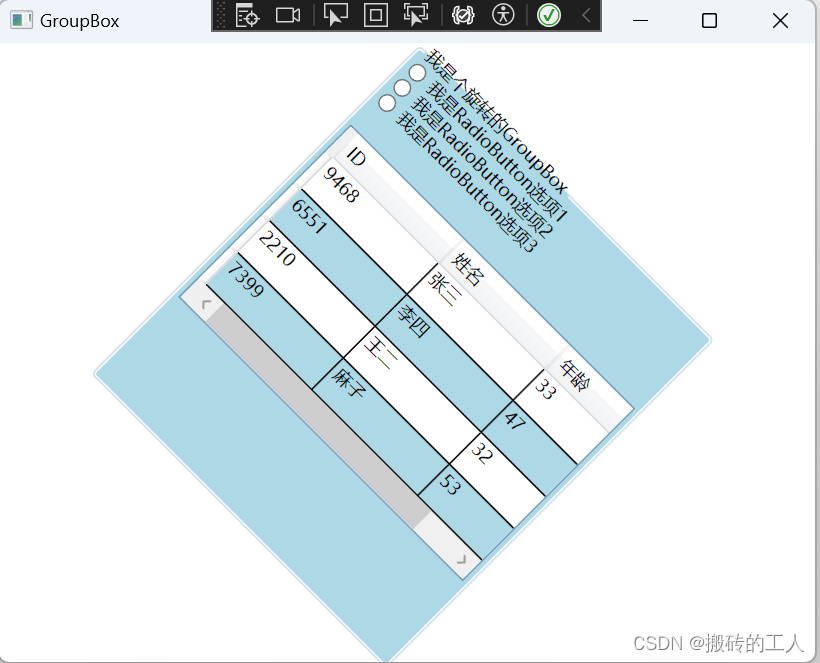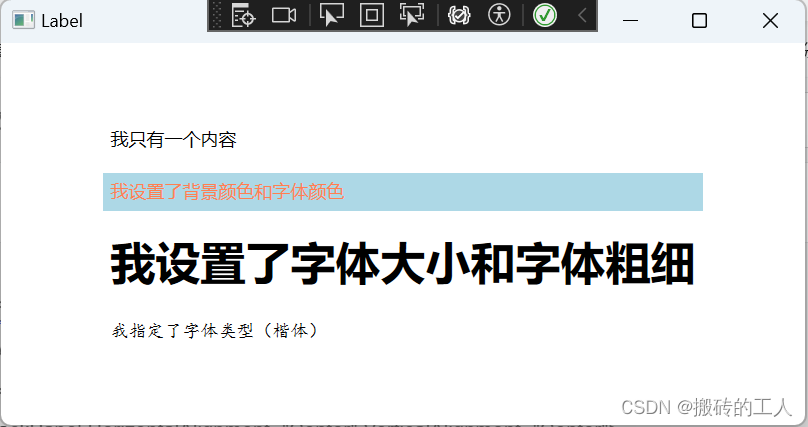深入了解WPF控件:基础概念与用法(四)
发布时间:2024年01月17日
掌握WPF控件:熟练常用属性(四)
DatePicker
- 用于用户通过将日期键入文本字段或使用下拉 Calendar 控件来选择日期。用户直接输入日期文本时,它会设置 Text 属性。 但会出现 DatePicker 无法转换为有效日期字符串的情况,这情况则将引发 DateValidationError 事件。 默认情况下,这会导致异常,但是可以在 DateValidationError 的事件里处理,把ThrowException 属性设置为 false,并阻止引发异常。
| 常用属性 | 描述 |
|---|---|
| BlackoutDates | 用于获取或设置标记为不可选择的日期的集合。 |
| CalendarStyle | 用于获取或设置呈现日历时使用的样式。 |
| DisplayDate | 用于获取或设置要显示的日期。 |
| DisplayDateEnd | 用于获取或设置要显示的最后一个日期。 |
| DisplayDateStart | 用于获取或设置要显示的第一个日期。 |
| FirstDayOfWeek | 用于获取或设置星期几为一周开始的日期。 |
| IsDropDownOpen | 用于获取或设置一个值,该值指示是打开还是关闭下拉 Calendar。 |
| IsTodayHighlighted | 用于获取或设置一个值,该值指示是否突出显示当前日期。这个属性就是Calendar控件里的属性。默认为true |
| SelectedDate | 用于获取或设置当前选定的日期。默认为null |
| SelectedDateFormat | 用于获取或设置用于显示所选日期的格式。默认值为 Long,可选值有:Short(于ToShortDateString() 返回的字符串一样)、Long(与 ToLongDateString() 返回的字符串一样) |
| Text | 用于获取由 DatePicker 显示的文本,或设置选定日期。 |
- 下面写一个例子
<Grid>
<Grid.RowDefinitions>
<RowDefinition Height="Auto"></RowDefinition>
<RowDefinition Height="Auto"></RowDefinition>
<RowDefinition Height="Auto"></RowDefinition>
</Grid.RowDefinitions>
<!--添加DateValidationError事件来阻止异常抛出-->
<!--设置SelectedDateFormat为Long,表示未缩写的星期几和月份名称显示日期-->
<DatePicker Grid.Row="0" Margin="0,20,0,0" Name="myDatePicker" Width="200" SelectedDateFormat="Long" DateValidationError="myDatePicker_DateValidationError"/>
<StackPanel Grid.Row="1" Orientation="Horizontal" HorizontalAlignment="Center" Margin="0,170,0,0" >
<Button Height="40" Width="150" Content="禁用部分日期不可选择" Click="Button_Click"></Button>
<Button Height="40" Width="150" Margin="10,0,0,0" Content="设置/取消日历样式" Click="Button_Click_1"></Button>
</StackPanel>
<StackPanel Grid.Row="2" Orientation="Horizontal" HorizontalAlignment="Center" Margin="0,10,0,0" >
<Button Height="40" Width="150" Content="设置日期为明天" Click="Button_Click_2"></Button>
<Button Height="40" Width="150" Margin="10,0,0,0" Content="设置开始和结束日期为下个月月初末" Click="Button_Click_3"></Button>
</StackPanel>
</Grid>
using System.Windows;
using System.Windows.Controls;
using System.Windows.Media;
namespace WpfCommonControls
{
/// <summary>
/// DatePicker.xaml 的交互逻辑
/// </summary>
public partial class DatePicker : Window
{
private static Random random = new Random();
int monthNum = 0; //用来动态改变日期
public DatePicker()
{
InitializeComponent();
}
private void Button_Click(object sender, RoutedEventArgs e)
{
// 设置部分不可选日期
//演示这里,我当月随机禁用十天
List<CalendarDateRange> blackoutDateList = new List<CalendarDateRange>();
//本月时间
DateTime startDate = new DateTime(DateTime.Now.Year, DateTime.Now.AddMonths(monthNum).Month, 1);
DateTime endDate = startDate.AddMonths(1+ monthNum).AddDays(-1);
for (int i = 0; i < 10; i++)
{
// 随机获取这个月的一天
int day = random.Next(1, DateTime.DaysInMonth(startDate.Year, startDate.Month));
DateTime randomDisabledDate = new DateTime(startDate.Year, startDate.Month, day);
// 创建并添加禁用日期范围
blackoutDateList.Add(new CalendarDateRange(randomDisabledDate, randomDisabledDate));
}
//清空历史禁用
myDatePicker.BlackoutDates.Clear();
foreach (var item in blackoutDateList)
{
// 将禁用日期列表应用到DatePicker
myDatePicker.BlackoutDates.Add(item);
}
// 并且手动打开看效果
myDatePicker.IsDropDownOpen=true;
}
private void myDatePicker_DateValidationError(object sender, DatePickerDateValidationErrorEventArgs e)
{
// 设置为false 阻止抛出异常
e.ThrowException = false;
}
private void Button_Click_1(object sender, RoutedEventArgs e)
{
if (myDatePicker.CalendarStyle != null)
{
myDatePicker.CalendarStyle = null; // 取消日历样式
}
else
{
//设置日历样式
Style cellStyle = new Style();
cellStyle.Setters.Add(new Setter(BackgroundProperty, Brushes.LightPink)); // 设置背景
cellStyle.Setters.Add(new Setter(ForegroundProperty, Brushes.Black)); // 设置字体颜色
cellStyle.Setters.Add(new Setter(BorderBrushProperty, Brushes.DarkBlue)); // 设置边框颜色
cellStyle.Setters.Add(new Setter(BorderThicknessProperty, new Thickness(2))); //设置边框线
myDatePicker.CalendarStyle = cellStyle; // 设置日历样式
}
// 并且手动打开看效果
myDatePicker.IsDropDownOpen = true;
}
private void Button_Click_2(object sender, RoutedEventArgs e)
{
// 在UI线程中设置新的DisplayDate
Application.Current.Dispatcher.Invoke(() =>
{
//设置日期为明天,日历里选择的日期
myDatePicker.DisplayDate = DateTime.Now.AddDays(1);
//设置输入框的信息
myDatePicker.Text = DateTime.Now.AddDays(1).ToLongDateString();
});
// 并且手动打开看效果
myDatePicker.IsDropDownOpen = true;
}
private void Button_Click_3(object sender, RoutedEventArgs e)
{
// 设置
monthNum = 1;//演示随机禁用时间跟随变化
// 设置日历的起始日期和结束日期
DateTime lastMonth = DateTime.Now.AddMonths(1);
myDatePicker.DisplayDateStart = new DateTime(DateTime.Now.Year, lastMonth.Month, 1); ;
myDatePicker.DisplayDateEnd = new DateTime(DateTime.Now.Year, lastMonth.AddMonths(1).Month, 1).AddDays(-1);
// 修改一周的开始为星期几,这里会修改默认的周日在一周的第一位
myDatePicker.FirstDayOfWeek = DayOfWeek.Tuesday;
// 并且手动打开看效果
myDatePicker.IsDropDownOpen = true;
}
}
}

GroupBox
- 用于创建一个具有用户界面(UI)内容边框和标题的容器。它只能包含一个子元素,但通过设置这个控件为面板,可以自由地向面板添加多个控件。
| 常用属性 | 描述 |
|---|---|
| Header | 用于获取或设置每个控件的标题所用的数据。 |
| RenderTransform | 用于元素的呈现位置的转换信息。例如GroupBox整个组件旋转45% |
| RenderTransformOrigin | 用于由RenderTransform声明的任何可能呈现转换的中心点,相对于元素的边界。 |
| Background | 用于控件的背景颜色。 |
- 下面写一个例子
<Grid>
<!--设置Header头文本,以及设置Background背景颜色-->
<!--设置RenderTransform 旋转45度不会影响元素的布局,它只会改变元素在屏幕上的呈现方式-->
<!--设置RenderTransformOrigin 旋转中心位置,设置为 (0.5, 0.5),表示变换的起始点位于GroupBox中心-->
<!--设置HorizontalContentAlignment为Right 表示组件内容内容右对齐-->
<GroupBox Header="我是个旋转的GroupBox" Width="280" Height="320" Background="LightBlue" >
<GroupBox.RenderTransform>
<RotateTransform Angle="45" />
</GroupBox.RenderTransform>
<GroupBox.RenderTransformOrigin>
<Point X="0.5" Y="0.5" />
</GroupBox.RenderTransformOrigin>
<GroupBox.Content>
<!--内容添加三个单选按钮和DataGrid表格-->
<StackPanel >
<RadioButton Content="我是RadioButton选项1" />
<RadioButton Content="我是RadioButton选项2" />
<RadioButton Content="我是RadioButton选项3" />
<DataGrid x:Name="myDataGrid1" Margin="0,20,0,0" AutoGenerateColumns="False" ColumnWidth="100" AlternatingRowBackground="LightBlue" AlternationCount ="2" CanUserAddRows ="False" CanUserDeleteRows="False" CanUserResizeRows="False" MinRowHeight="30.0">
<DataGrid.Columns>
<!-- 定义列 -->
<DataGridTextColumn Header="ID" Binding="{Binding Id}" />
<DataGridTextColumn Header="姓名" Binding="{Binding Name}" />
<DataGridTextColumn Header="年龄" Binding="{Binding Age}" />
</DataGrid.Columns>
</DataGrid>
</StackPanel>
</GroupBox.Content>
</GroupBox>
</Grid>
using System.Windows;
namespace WpfCommonControls
{
/// <summary>
/// GroupBox.xaml 的交互逻辑
/// </summary>
public partial class GroupBox : Window
{
static Random random = new Random();
public GroupBox()
{
InitializeComponent();
LoadData();
}
private void LoadData()
{
List<PersonModel> list = new List<PersonModel>
{
new PersonModel { Id=random.Next(1, 10001), Name = "张三", Age = random.Next(18, 61) },
new PersonModel {Id=random.Next(1, 10001), Name = "李四", Age = random.Next(18, 61) },
new PersonModel {Id=random.Next(1, 10001), Name = "王二", Age = random.Next(18, 61) },
new PersonModel {Id=random.Next(1, 10001), Name = "麻子", Age = random.Next(18, 61) }
};
// 设置DataGrid的数据上下文
myDataGrid1.ItemsSource = list;
}
public class PersonModel
{
/// <summary>
/// ID
/// </summary>
public int Id { get; set; }
/// <summary>
/// 姓名
/// </summary>
public string? Name { get; set; }
/// <summary>
/// 年龄
/// </summary>
public int Age { get; set; }
}
}
}

Label
- 用于在用户界面(UI)中提供信息。Label 控件通常用于显示文本或其他内容,并允许用户通过快捷键快速访问相关控件。
| 常用属性 | 描述 |
|---|---|
| Content | 用于设置或获取Label控件中显示的文本内容。 |
| Foreground | 用于设置或获取Label控件前景色(即文本颜色)。 |
| Background | 用于设置或获取Label控件的背景色。 |
| FontFamily | 用于设置或获取Label控件中字体族。 |
| FontSize | 用于设置或获取Label控件中字体大小。 |
| FontWeight | 用于设置或获取Label控件中字体粗细。 |
- 下面写一个例子
<Grid>
<StackPanel HorizontalAlignment="Center" VerticalAlignment="Center">
<Label Content="我只有一个内容" />
<Label Margin="0,10,0,0" Content="我设置了背景颜色和字体颜色" Background="LightBlue" Foreground="Coral"/>
<Label Margin="0,10,0,0" Content="我设置了字体大小和字体粗细" FontSize="30" FontWeight="Bold"/>
<Label Margin="0,10,0,0" Content="我指定了字体类型(楷体)" FontFamily="KaiTi"/>
</StackPanel>
</Grid>

Popup
- 是一个轻量级的容器,可以在其内容部分显示其他控件。Popup 控件可以用来创建各种用户界面元素,如上下文菜单、浮动工具栏、弹出窗口等。
| 常用属性 | 描述 |
|---|---|
| AllowsTransparency | 用于获取或设置一个值,该值指示 Popup 控件是否可以包含透明内容。 |
| Child | 用于获取或设置 Popup 控件的内容。 |
| HorizontalOffset | 用于获取或设置目标原点和弹出对齐点之间的水平距离。 |
| Placement | 用于获取或设置 Popup 控件打开时的控件方向(默认为Bottom下方),并指定 Popup 控件在与屏幕边界重叠时的控件行为。 |
| PlacementRectangle | 用于获取或设置当打开 Popup 控件时该控件相对于其放置的矩形。 |
| PlacementTarget | 用于获取或设置 Popup 打开时相对于其定位的元素。 |
| PopupAnimation | 用于获取或设置用于打开和关闭 Popup 控件的动画。默认值为 None。可选值有:Fade(淡入)、None(无)、Scroll(左上角滚动)、Slide(向下或向上滑动) |
| StaysOpen | 用于获取或设置一个值,该值指示当 Popup 控件焦点不再对准时,是否关闭该控件。为true 时候,显示后不会关闭 |
| VerticalOffset | 用于获取或设置目标原点和弹出对齐点之间的垂直距离。 |
- 下面写一个例子
<Grid>
<Grid.RowDefinitions>
<RowDefinition></RowDefinition>
<RowDefinition></RowDefinition>
<RowDefinition></RowDefinition>
<RowDefinition></RowDefinition>
</Grid.RowDefinitions>
<Button x:Name="myButton" Grid.Row="0" Height="40" Width="150" Content="打开一个透明Popup" Click="Button_Click"></Button>
<!--设置AllowsTransparency为true,表示支持透明度-->
<!--设置PopupAnimation动画为Slide表示淡入出现-->
<!--设置PlacementTarget目标元素为按钮,打开默认在按钮下面-->
<Popup x:Name="myPopup" AllowsTransparency="True" PopupAnimation="Fade" PlacementTarget="{Binding ElementName=myButton}">
<Popup.Child>
<TextBlock Background="LightPink">我是一个透明背景的Popup</TextBlock>
</Popup.Child>
</Popup>
<Button x:Name="myButton1" Grid.Row="1" Height="40" Width="150" Content="手动打开/关闭Popup" Click="myButton1_Click"></Button>
<!--设置PopupAnimation动画为None表示无动画-->
<!--设置PlacementTarget目标元素为按钮,打开默认在按钮下面-->
<!--设置StaysOpen为true时候点击其他地方不会自动关闭,只能手动设置IsOpen=false关闭-->
<Popup x:Name="myPopup1" StaysOpen="True" PopupAnimation="None" PlacementTarget="{Binding ElementName=myButton1}">
<Popup.Child>
<TextBlock Background="LightGreen">我设置StaysOpentrue,点击其他地方不会关闭</TextBlock>
</Popup.Child>
</Popup>
<Button x:Name="myButton2" Grid.Row="2" Height="40" Width="150" Content="我是有水平和垂直偏移的" Click="myButton2_Click"></Button>
<!--设置PopupAnimation动画为Scroll表示左上角滚动出现-->
<!--设置PlacementTarget目标元素为按钮,打开默认在按钮下面-->
<!--设置了水平偏移HorizontalOffset为20,垂直偏移 为20,因此它会往下偏移20,往右偏移20-->
<Popup x:Name="myPopup2" HorizontalOffset="20" VerticalOffset="20" PopupAnimation="Scroll" PlacementTarget="{Binding ElementName=myButton2}">
<Popup.Child>
<TextBlock Background="AliceBlue">我设置HorizontalOffset和VerticalOffset,因此会水平和垂直偏移</TextBlock>
</Popup.Child>
</Popup>
<Button x:Name="myButton3" Grid.Row="3" Height="40" Width="150" Content="我是设置矩形来显示位置" Click="myButton3_Click"></Button>
<!--设置PopupAnimation动画为Slide表示上王下滑动-->
<!--设置PlacementTarget目标元素为按钮,打开默认Placement为Bottom在按钮下面,-->
<!--设置Placement为left 表示在左边-->
<!--设置PlacementRectangle的X为50、 Y为50、 Width为50和 Height为100-->
<Popup x:Name="myPopup3" PlacementRectangle="50,50,50,100" Placement="Left" PopupAnimation="Slide" PlacementTarget="{Binding ElementName=myButton3}">
<Popup.Child>
<TextBlock Background="LightYellow">我设置PlacementRectanglel 矩形来显示位置</TextBlock>
</Popup.Child>
</Popup>
</Grid>
using System.Windows;
namespace WpfCommonControls
{
/// <summary>
/// Popup.xaml 的交互逻辑
/// </summary>
public partial class Popup : Window
{
public Popup()
{
InitializeComponent();
}
private void Button_Click(object sender, RoutedEventArgs e)
{
//打开
myPopup.IsOpen = true;
}
private void myButton1_Click(object sender, RoutedEventArgs e)
{
//手动切换打开和关闭,用来演示StaysOpen 为ture时,只能手动关闭
myPopup1.IsOpen = !myPopup1.IsOpen;
}
private void myButton2_Click(object sender, RoutedEventArgs e)
{
//打开
myPopup2.IsOpen = true;
}
private void myButton3_Click(object sender, RoutedEventArgs e)
{
//打开
myPopup3.IsOpen = true;
}
}
}

公众号“点滴分享技术猿”

文章来源:https://blog.csdn.net/u010784529/article/details/135615933
本文来自互联网用户投稿,该文观点仅代表作者本人,不代表本站立场。本站仅提供信息存储空间服务,不拥有所有权,不承担相关法律责任。 如若内容造成侵权/违法违规/事实不符,请联系我的编程经验分享网邮箱:chenni525@qq.com进行投诉反馈,一经查实,立即删除!
本文来自互联网用户投稿,该文观点仅代表作者本人,不代表本站立场。本站仅提供信息存储空间服务,不拥有所有权,不承担相关法律责任。 如若内容造成侵权/违法违规/事实不符,请联系我的编程经验分享网邮箱:chenni525@qq.com进行投诉反馈,一经查实,立即删除!
最新文章
- Python教程
- 深入理解 MySQL 中的 HAVING 关键字和聚合函数
- Qt之QChar编码(1)
- MyBatis入门基础篇
- 用Python脚本实现FFmpeg批量转换
- 把控“生命线” --小可智能呼救报警器测评
- 使用helm部署 redis 单机版
- Vue再次接触后
- cpp_11_虚函数_多态_纯虚函数
- 直播回顾 | 张乐、何勉、余伟、任晶磊共议研发效能的破局之道
- 四川思维跳动商务信息咨询有限公司可信吗?
- Dev c++(5.11)使用一段时间后突然打不开
- Python 数据分析 Matplotlib篇 时间序列数据绘制折线图(第4讲)
- gh0st远程控制——客户端界面编写(一)
- C++ 二叉搜索树(BST)的实现(非递归版本与递归版本)与应用